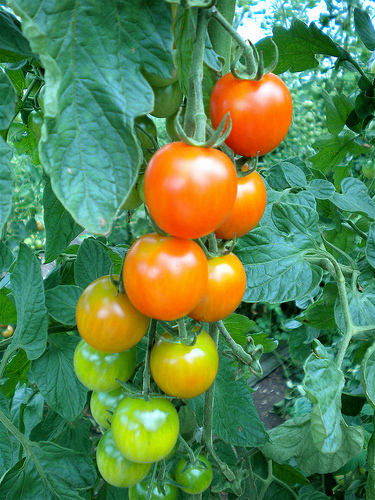Assessing & Planning
Business Plan/Whole Farm Planning
Adam and Laura grow up to 250 varieties of 40-50 different crops, including vegetables, herbs, flowers, and some fruits. They chose to emphasize annual vegetables as their main product for a couple of different reasons. When they started out they were vegetarians, so for dietary reasons livestock farming was not a compelling choice.
|
They were, and continue to be, interested in fruit trees and other perennials, but they wanted an enterprise that simplified start-up. As outlined in one of their articles at New Farm, the appeal of producing food for others and having a consistent product throughout the growing season, plus having access to the knowledge and resources of Gardens of Eagan, made vegetables the logical focus for them (Figure 11). |
 Figure 11: Laura and Adam wanted to focus on high-yielding annuals, such as tomatoes, when they started out. |
Laura and Adam put together a business plan in 2005 before they started farming on their own. It evolved into their initial production plan, with lists of selected crops and the associated details needed for each one (e.g., seeding vs. transplanting, fertilizing, harvesting/handling, equipment). With time, the business plan became more focused on overarching issues, such as goals and mission, and on finances. The production planning became linked to their organic certification process.
Adam and Laura review their business plan each winter, compiling and evaluating financial information from the previous season. The indicators they track most closely are finances and crop yields, though they also consider personal indicators, such as how stressful the season was. During the growing season, they have weekly meetings to review their financial picture. Growing plans and/or the farm budget sometimes need to be adapted as the season progresses depending on weather, pests, and diseases. In 2009, for example, a summer drought resulted in less product than anticipated for their farmers market sales. They increased fall production by planting more than they had originally planned and were able to make up what they had lost over the summer through fall sales.
Laura and Adam have not engaged in whole farm planning, but they feel it’s their next step and may attend a course soon. At the beginning, whole farm planning felt too overwhelming. Now, with five years of experience and a farm to call their own, the issues to be addressed seem more manageable and pertinent.
| Educator’s Perspective: Resource Tip Business Planning A MISA publication called Building a Sustainable Business: A Guide to Developing a Business Plan for Farms and Rural Businesses assists with the creation of a holistic business plan rooted in personal, community, economic, and environmental values. A free online course called Strategic Farm/Ranch Planning and Marketing, one of a series in SARE’s National Continuing Education Program in Sustainable Agriculture, covers goal setting, developing business and marketing plans, managing risk, meeting with lenders and alternative financing, transferring farms, and understanding retirement options. A free online business planning tool called AgPlan, from the Center for Farm Financial Management, offers tips and resources for writing a plan and provides an option for getting it reviewed. The U.S. Small Business Administration has Small Business Development Centers throughout the country that offer free consultations for business planning. Click here for an office locator. |